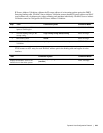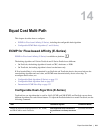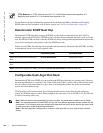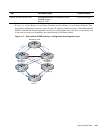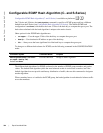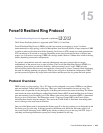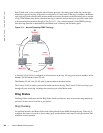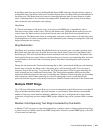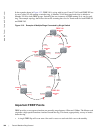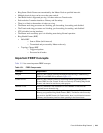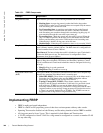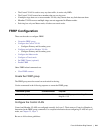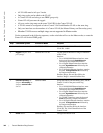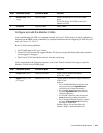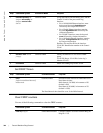Force10 Resilient Ring Protocol | 337
If the Master node does not receive the Ring Health Frame (RHF) before the fail-period timer expires (a
configurable timer), the Master node moves from the Normal state to the Ring-Fault state and unblocks its
Secondary port. The Master node also clears its forwarding table and sends a control frame to all other
nodes, instructing them to also clear their forwarding tables. Immediately after clearing its forwarding
table, each node starts learning the new topology.
Ring Failure
If a Transit node detects a link down on any of its ports on the FRRP ring, it immediately sends a
link-down control frame on the Control VLAN to the Master node. When the Master node receives this
control frame, the Master node moves from the Normal state to the Ring-Fault state and unblocks its
Secondary port. The Master node clears its routing table, and sends a control frame to all other ring nodes,
instructing them to clear their routing tables as well. Immediately after clearing its routing table, each node
begins learning the new topology.
Ring Restoration
The Master node continues sending Ring Health Frames out its primary port even when operating in the
Ring-Fault state. Once the ring is restored, the next status check frame is received on the Master node's
Secondary port. This will cause the Master node to transition back to the Normal state. The Master node
then logically blocks non-control frames on the Secondary port, clears its own forwarding table, and sends
a control frame to the Transit nodes, instructing them to clear their forwarding tables and re-learn the
topology.
During the time between the Transit node detecting that its link is restored and the Master node detecting
that the ring is restored, the Master node’s Secondary port is still forwarding traffic. This can create a
temporary loop in the topology. To prevent this, the Transit node places all the ring ports transiting the
newly restored port into a temporary blocked state. The Transit node remembers which port has been
temporarily blocked and places it into a pre- forwarding state. When the Transit node in the pre-forwarding
state receives the control frame instructing it to clear its routing table, it does so and unblocks the
previously blocked ring ports on the newly restored port. Then the Transit node returns to the Normal state.
Multiple FRRP Rings
Up to 255 rings allowed per system. However, it is not recommended on the S-Series to have more than 34
rings on the same interface (either a physical interface or a portchannel). More than the recommended
number of rings may cause interface instability. Multiple rings can be configured with a single switch
connection; a single ring can have multiple FRRP groups; multiple rings can be connected with a common
link.
Member VLAN Spanning Two Rings Connected by One Switch
A Member VLAN can span two rings interconnected by a common switch, in a figure-eight style topology.
A switch can act as a Master node for one FRRP Group and a Transit for another FRRP group, or it can be
a Transit node for both rings.



